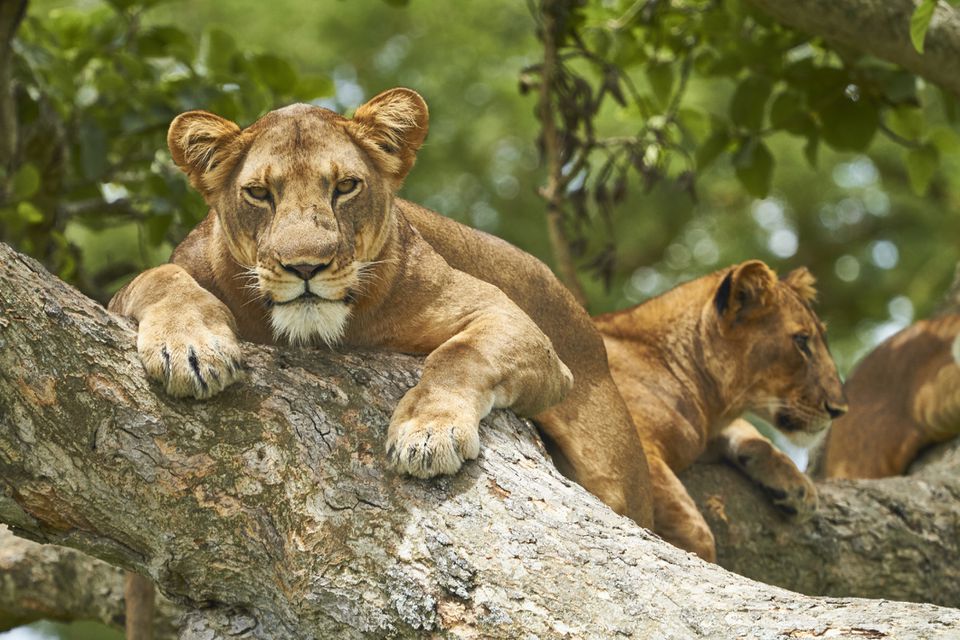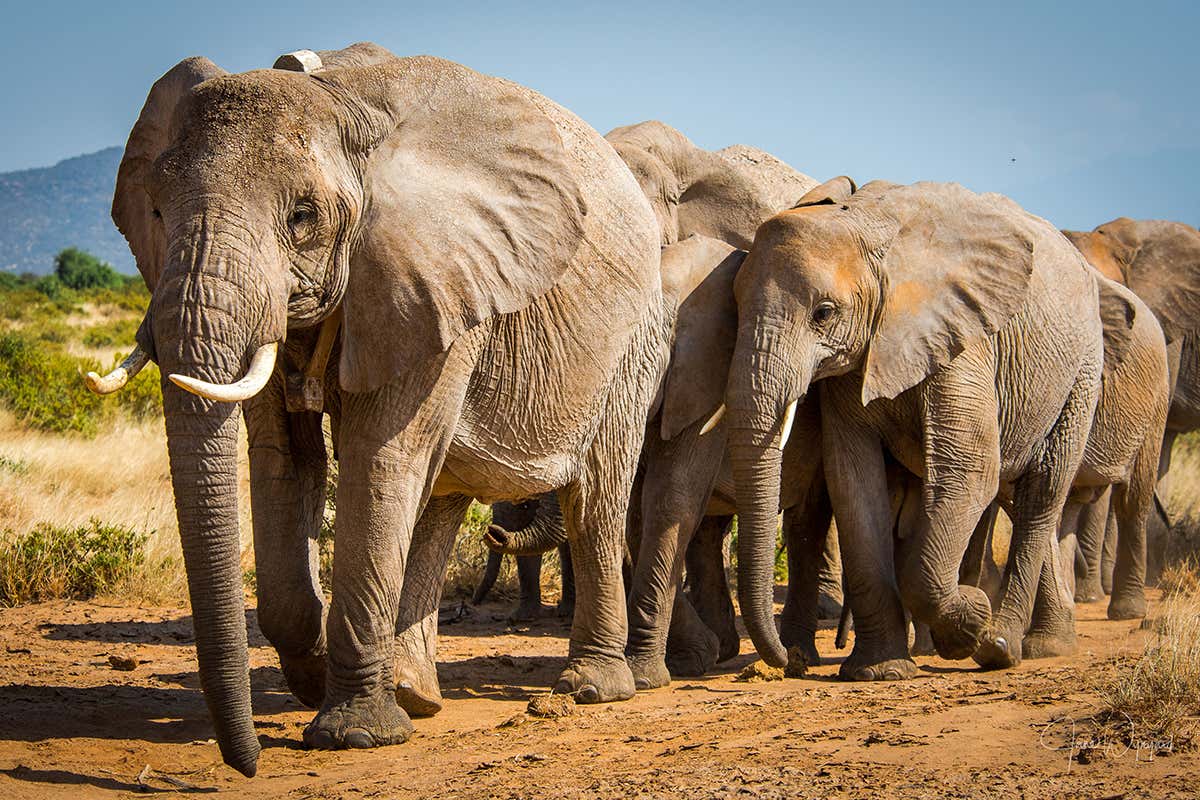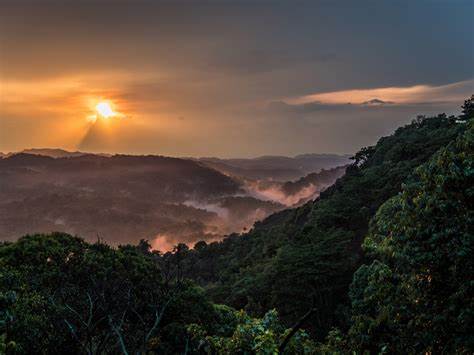Lion spotting is a major highlight for Ugandan safaris, second only to tracking the magnificent mountain gorillas. Three national parks offer prime opportunities to see these majestic predators:
Queen Elizabeth National Park: Home to the famous Ishasha tree-climbing lions, a sight unique to this area.
Murchison Falls National Park: Keep an eye out for the park’s well-known three-legged lion.
Kidepo Valley National Park: This off-the-beaten-path park boasts an abundance of lions thriving in a less-disturbed environment.
Here are 5 Facts about Lions
The lioness is the pride’s primary hunter.
Their leaner bodies and agility make them more adept at stalking and chasing prey than the bulkier males. A lioness typically needs around 5 kilograms of meat daily, while a male lion requires about 7 kilograms.
Despite their hunting prowess, lionesses follow a social hierarchy within the pride. After a successful hunt, the male lion, often the pride leader, typically eats first. This ensures he remains strong enough to defend the pride from external threats like rival males. The lionesses and cubs wait their turn, understanding a well-fed leader provides better protection.
While lionesses are the dominant hunters, they may sometimes resort to scavenging. They might follow vultures circling in the sky, which can lead them to carcasses from other predators’ kills.
A Lion’s mane says a lot about it.
The majestic mane is a lion’s crowning glory, though not all males sport this impressive feature. This thick fur around the neck, head, and chest starts to appear when a lion is around a year old. By the age of two, it’s fully grown, reaching its peak size at three or four years old. Interestingly, lions in captivity often develop larger manes than their wild counterparts.
Beyond its visual grandeur, the mane serves several purposes. The darkness of the mane reflects a male’s age, with a darker mane signifying seniority. This can be attractive to lionesses, who may favor stronger, more experienced mates. The mane also broadcasts the lion’s health and fighting prowess, both to his pride and rival males. A full, dark mane can warn rivals of a formidable opponent and deter conflict.

Lions are social
Lions are unique among big cats for their social behavior. Unlike their solitary relatives (tigers, leopards, cheetahs), lions live in prides. This social structure is driven by survival.
Larger prides have a distinct advantage. They can dominate a wider territory, particularly areas near water sources where prey congregates, making hunting more efficient. These prime territories often become battlegrounds, with smaller prides relegated to the fringes.
A typical pride consists of 10 to 15 lions, including females, cubs, and one or two males. The social order revolves around these males. As young males mature (around 2-3 years old), they are compelled by instinct to leave their natal pride and seek their own. These lone males, sometimes accompanied by a brother or another “singleton,” will attempt to take over existing prides by challenging the dominant male. Success often leads to the expulsion or death of the existing male lions and mating rights with the pride’s females. Unsuccessful males may be forced into a solitary existence.
Habitat loss is a major threat to lions.
Despite reigning supreme as apex predators, lions face a significant threat: habitat loss. This critical issue has led to their classification as “vulnerable” on the International Union for Conservation of Nature’s (IUCN) Red List of Threatened Species.
Lions’ historic range was vast, encompassing Asia, Europe, and much of Africa. Today, they cling to existence solely in Africa, with populations dramatically reduced.
Lions are Nocturnal
Lions are renowned for their love of sleep, logging in up to 20 hours a day. This means they’re typically active for just 4-5 hours, primarily at dusk and dawn when temperatures are cooler. However, access to water can influence their behavior. In territories with abundant water sources, lions may become more active during the day, occasionally even hunting under the sun.






Выбор аппаратуры для косметологии — важный процесс в развитии салона.
Прежде всего стоит уточнить задачи и направления, которые вы планируете предоставлять.
Необходимо проверить разрешения и надёжность выбранного инструмента.
Отзывы прошлых специалистов помогут принять уверенный подбор.
купить IPL-эпилятор профессиональный
Также следует обратить внимание на многофункциональность и удобство эксплуатации.
Первая проверка оборудования позволяет понять комфорт работы.
Не забудьте оценить стоимость и гарантийные условия.
Правильный выбор косметологического оборудования позволит улучшить качество процедур.
Поиск врача-остеопата — ответственный шаг на пути к реабилитации.
Для начала стоит понять свои задачи и ожидания от терапии у остеопата.
Необходимо проверить квалификацию и стаж выбранного остеопата.
Отзывы клиентов помогут сформировать уверенный подбор.
https://tr.pinterest.com/pin/673921531773952684/
Также необходимо обратить внимание методы, которыми пользуется специалист.
Первая встреча помогает оценить, насколько удобно вам общение и подход доктора.
Важно сравнить тарифы и формат работы (например, очно).
Правильный выбор врача способен ускорить лечение.
Здесь собрана интересная и полезная информация по разным темам.
Читатели могут найти ответы на популярные проблемы.
Статьи размещаются регулярно, чтобы вы каждый могли получать актуальную информацию.
Удобная структура сайта облегчает быстро отыскать нужные материалы.
https://admvzvad.ru/onlajn-razvlecheniya/pravda-o-domashnee-porno-mify-i-realnost/
Большое количество категорий делает ресурс универсальным для разных пользователей.
Любой сможет подобрать сведения, которые нужны именно вам.
Наличие практических советов делает сайт максимально значимым.
Таким образом, данный сайт — это удобный проводник важной информации для любого пользователей.
Современное медицинское оборудование играет значительную часть в обследовании и помощи пациентов.
Медицинские центры всё чаще оборудуются передовую аппаратуру.
Это позволяет докторам ставить правильные оценки.
Актуальные приборы обеспечивают надёжность и для больных, и для медиков.
http://www.tombru.com/mushing/index.php?topic=1681.new#new
Внедрение высоких технологий помогает эффективное лечение.
Часто устройства включают функции для точного наблюдения состояния здоровья.
Доктора могут быстро реагировать, основываясь на данных аппаратуры.
Таким образом, новейшее медоборудование повышает эффективность медицины.
На этом сайте размещена увлекательная и полезная сведения по разнообразным вопросам.
Гости могут обнаружить решения на важные вопросы.
Контент пополняются регулярно, чтобы вы могли читать актуальную информацию.
Простая организация сайта способствует быстро отыскать нужные разделы.
порно
Разнообразие тем делает ресурс полезным для многих пользователей.
Любой сможет выбрать сведения, которые нужны именно ему.
Наличие практических рекомендаций делает сайт максимально ценным.
Таким образом, площадка — это удобный проводник актуальной информации для любого пользователей.
Нейросетевые онлайн-сервисы для поиска информации становятся всё более популярными.
Они дают возможность находить доступные данные из социальных сетей.
Такие решения используются для аналитики.
Они умеют точно систематизировать большие объёмы информации.
бот гдаз брга
Это помогает сформировать более объективную картину событий.
Некоторые системы также включают удобные отчёты.
Такие сервисы активно применяются среди исследователей.
Развитие технологий делает поиск информации эффективным и удобным.
Нейросетевые онлайн-сервисы для поиска информации становятся всё более популярными.
Они дают возможность находить публичные данные из социальных сетей.
Такие инструменты используются для аналитики.
Они умеют оперативно систематизировать большие объёмы данных.
чат глаз бога
Это способствует сформировать более точную картину событий.
Отдельные системы также предлагают удобные отчёты.
Такие сервисы широко используются среди специалистов.
Совершенствование технологий превращает поиск информации эффективным и наглядным.
Интеллектуальные онлайн-сервисы для поиска информации становятся всё более удобными.
Они позволяют собирать доступные данные из интернета.
Такие боты подходят для журналистики.
Они способны оперативно обрабатывать большие объёмы контента.
бот глаз бога в телеге
Это позволяет сформировать более объективную картину событий.
Отдельные системы также обладают инструменты фильтрации.
Такие сервисы активно применяются среди аналитиков.
Развитие технологий превращает поиск информации эффективным и быстрым.
Нейросетевые боты для анализа данных становятся всё более удобными.
Они помогают находить публичные данные из разных источников.
Такие боты применяются для журналистики.
Они способны оперативно анализировать большие объёмы информации.
глаз боба тг
Это помогает получить более объективную картину событий.
Многие системы также предлагают функции визуализации.
Такие боты активно применяются среди исследователей.
Эволюция технологий делает поиск информации доступным и быстрым.
The site features a lot of fascinating and useful information.
On this platform, you can learn about various materials that expand knowledge.
Readers will appreciate the content shared through this platform.
Every page is well-structured, making it pleasant to use.
The articles are presented professionally.
The site includes guides on numerous themes.
If you want to find educational content, this site has everything you need.
To sum up, this website is a great source for information seekers.
https://sppiotrowice.info/
Получение ПМЖ за границей становится всё более востребованным среди россиян.
Такой статус предоставляет новые возможности для жизни.
ВНЖ помогает легче пересекать границы и избегать визовых ограничений.
Помимо этого такой документ может улучшить уровень личной безопасности.
Паспорт Греции
Многие россияне рассматривают ПМЖ как инструмент защиты.
Оформляя ВНЖ или второй паспорт, человек расширить свои связи за рубежом.
Каждая страна предлагают свои программы получения гражданства.
Вот почему тема получения становится особенно актуальной для тех, кто думает о будущем.
This online platform contains a lot of interesting and valuable information.
Here, you can learn about various materials that broaden your horizons.
Visitors will value the resources shared on this site.
All topics is easy to navigate, making it simple to use.
The posts are written clearly.
You can find tips on different subjects.
Whether your interest is in inspiration, this site has something for everyone.
All in all, this site is a great source for people who enjoy discovering new things.
https://bloodisblood-movie.com/
Casino Roulette: Spin for the Ultimate Thrill
Experience the timeless excitement of Casino Roulette, where every spin brings a chance to win big and feel the rush of luck. Try your hand at the wheel today at https://k8o.jp/ !
Having trouble logging into 12bet? This 12betlogin link is all I use, never had any problems. Makes logging in a breeze so I can get back to betting!
515bet5 – So, 515bet5 is in the mix. Gave it a look, and honestly, the selection of games kept me busy for a whole day. The customer service was great and super helpful. Do give 515bet5 a go, it’s a fun experience! 515bet5
Way cool! Some extremely valid points! I appreciate you penning this article and the rest of the site is also very good.